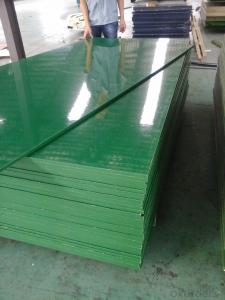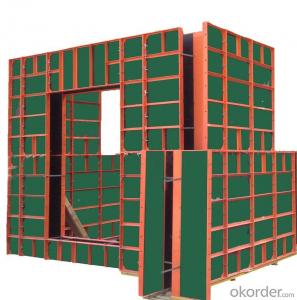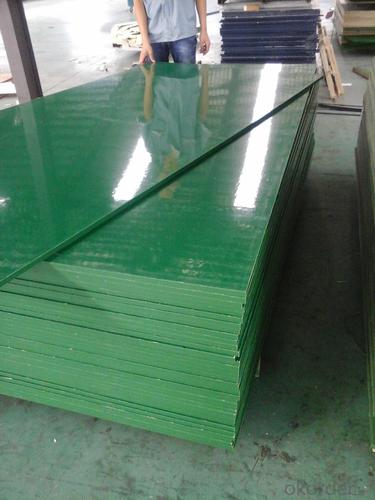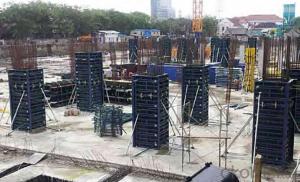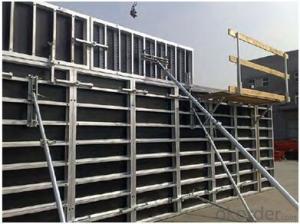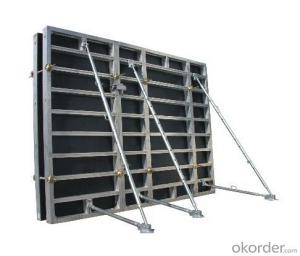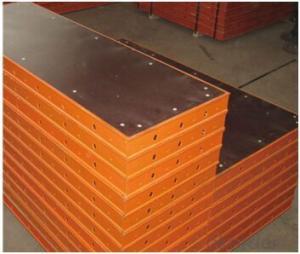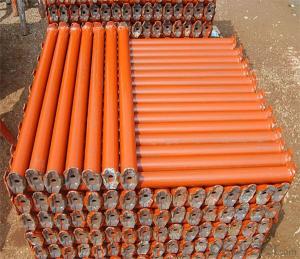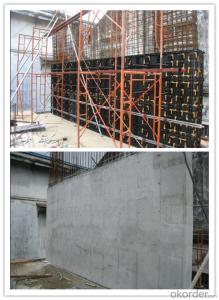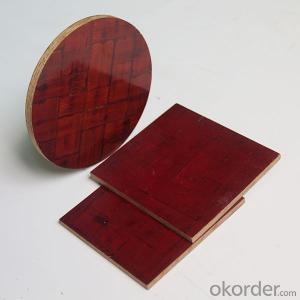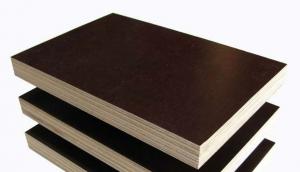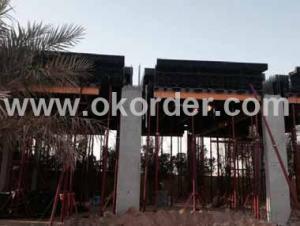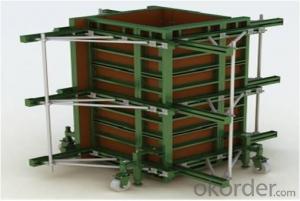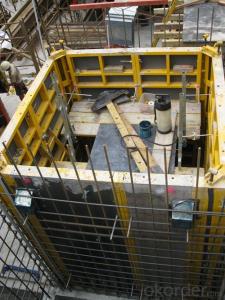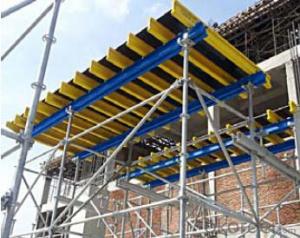WPC Plyform steel frame with plywood reusable for concrete forming
- Loading Port:
- Qingdao
- Payment Terms:
- TT OR LC
- Min Order Qty:
- 3000 m²
- Supply Capability:
- 60000 m²/month
OKorder Service Pledge
OKorder Financial Service
You Might Also Like
What's ?
Plywood coated with Plastic, on face/back/edge.
Plastic is PP ( Polypropylene) 0.3mm /0.5mm , finish is glossy , shiny , anti-slip (wire-mesh) .
PP is super in waterproof,durable, and easy dismantle from concrete, which let the products repeatable .
Plywood is made of poplar A grade, phenolic WBP glue, 2 time hotpress, both side sanded, plastic , MC 8-14%, tolerance +/-0.2mm.
Size: 915x1830 mm (3x6) , 1220x2440mm (4x8) , 1250x2500mm ,1220x2745mm (4x9) , 1220x3050 mm (4x10).
Thickness: 12mm 15mm 18mm 21mm
Application :
for concrete forming of walls, slabs, beams & columns
Installation
as easy as film faced plywood, but no need release agent
Dismantling
Handle carefully without violent damage and scratch to ensure more usage in good condition
Cleaning
Just clean by water
Maintenance & Storage
No oil treatment, place the panel flat, away from direct sunlight and water.
Why us?
1) repeatable more than 30 times, if in formwork system, can repeat 100 times.
2) core poplar /hardwood ,phenolic WBP glue. Bending strength 51 Mpa, Modulus of Elasticity 5600 Mpa. VERY STRONG than WPC..
3) face/back, plastic ( polypropylene 0.3mm), glossy/wiremesh/matt. no chlorine.
4) edge sealed by plastic tape.
5) nice concrete finish
6) easy clean,by water, wearable and resistant chemical.
7) holes can be filled by our plastic nails.
8) plastic PP can be recycle, environmental sound.
Hope to get your feedback charles at scformwork dot com
- Q: How does steel frame formwork handle concrete pouring at different heights?
- Steel frame formwork is designed to handle concrete pouring at different heights by providing a sturdy and reliable support system. The steel frames can be adjusted or extended to accommodate varying heights, ensuring that the concrete is poured accurately and securely. This formwork system also allows for easy installation and disassembly, making it efficient and cost-effective for construction projects requiring concrete pouring at different elevations.
- Q: Can steel frame formwork be used in marine or coastal construction?
- Yes, steel frame formwork can be used in marine or coastal construction. Steel is a durable and corrosion-resistant material that can withstand the harsh conditions present in marine environments. It provides the necessary strength and stability for concrete structures in coastal areas, making it a suitable choice for formwork.
- Q: Can steel frame formwork be integrated with other construction systems?
- Yes, steel frame formwork can be integrated with other construction systems. It is a versatile system that can be easily adapted and combined with various construction methods and materials, allowing for efficient and effective construction processes.
- Q: Stone curtain wall steel frame in the 90 degree angle of the horizontal frame connection
- Lap welding, if left and right sub grid is relatively large with the column
- Q: How does steel frame formwork handle different types of concrete surface protection methods?
- Steel frame formwork is versatile and can handle different types of concrete surface protection methods effectively. The steel frame provides a strong and stable structure, allowing for the application of various surface protection methods such as waterproofing membranes, coatings, or sealants. The formwork can accommodate the additional weight or thickness of these protection methods without compromising its structural integrity. Additionally, steel frame formwork allows for easy installation and removal of the protection materials, enabling efficient and precise application.
- Q: How does steel frame formwork handle different types of concrete consolidation methods?
- Steel frame formwork is a versatile and robust system that can effectively handle different types of concrete consolidation methods. Whether it is traditional concrete vibration, self-consolidating concrete (SCC), or any other method, steel frame formwork provides the necessary support and stability to ensure proper consolidation. One of the main advantages of steel frame formwork is its ability to withstand the high pressure and forces generated during concrete consolidation. The steel frames are designed to be strong and rigid, allowing them to hold the weight of the concrete and resist any deformation. This ensures that the formwork remains in place and maintains its shape even under heavy consolidation forces. In the case of traditional concrete vibration, steel frame formwork provides a stable platform for the vibrating equipment. The formwork is securely attached to the structure, preventing any movement or displacement during the vibration process. This allows for efficient consolidation of the concrete and helps to eliminate any potential voids or air pockets. When it comes to self-consolidating concrete (SCC) or other flowable fill materials, steel frame formwork can be adapted to accommodate the specific requirements. The formwork can be modified to have larger openings or additional access points to facilitate the pouring and flow of the self-consolidating concrete. The steel frames can also be designed with adjustable brackets or clamps to provide the necessary flexibility to shape and mold the SCC as desired. Furthermore, steel frame formwork can easily accommodate the use of different consolidation methods simultaneously. For example, if a project requires a combination of traditional concrete vibration and SCC, the formwork can be designed and set up to accommodate both methods. This allows for efficient and versatile construction processes, ensuring the best possible consolidation of the concrete. In conclusion, steel frame formwork is well-suited to handle different types of concrete consolidation methods. Its strength, stability, and adaptability make it an ideal choice for various construction projects. Whether it is traditional concrete vibration, SCC, or any other method, steel frame formwork provides the necessary support and flexibility to ensure proper consolidation and a high-quality end result.
- Q: Can steel frame formwork be used for concrete slabs on grade?
- Yes, steel frame formwork can be used for concrete slabs on grade. Steel frame formwork is a versatile and strong option that can provide support and stability for pouring concrete slabs on grade. It is commonly used in construction projects where durability and reusability are important factors.
- Q: How does steel frame formwork accommodate different shapes and sizes of concrete structures?
- Steel frame formwork is a versatile system that can easily adapt to different shapes and sizes of concrete structures. The steel frames can be easily adjusted and reinforced to create various configurations and dimensions, allowing for the construction of complex geometries. Additionally, the formwork panels can be customized and connected together to fit specific requirements, ensuring the accurate shaping of the concrete structure. This flexibility and adjustability of steel frame formwork make it an ideal choice for accommodating different shapes and sizes in concrete construction projects.
- Q: How does steel frame formwork contribute to the overall versatility of a construction project?
- Steel frame formwork contributes to the overall versatility of a construction project by providing a highly adaptable and reusable system for creating concrete structures. Its modular design allows for easy assembly and disassembly, enabling quick adjustments or changes to the formwork layout. Additionally, the strength and durability of steel make it capable of supporting large concrete loads and withstanding harsh construction conditions. This versatility allows for the construction of various types of structures, shapes, and sizes, making steel frame formwork an essential tool in modern construction projects.
- Q: What is the average time required for assembling and disassembling steel frame formwork?
- The average time required for assembling and disassembling steel frame formwork can vary depending on the size and complexity of the structure. However, in general, it can take anywhere from a few hours to a few days for experienced workers to complete the process.
Send your message to us
WPC Plyform steel frame with plywood reusable for concrete forming
- Loading Port:
- Qingdao
- Payment Terms:
- TT OR LC
- Min Order Qty:
- 3000 m²
- Supply Capability:
- 60000 m²/month
OKorder Service Pledge
OKorder Financial Service
Similar products
Hot products
Hot Searches
Related keywords
